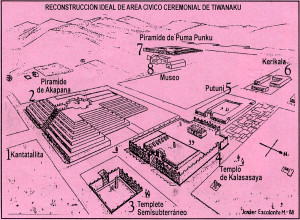ancient astronaut
Pumapunku
 Pumapunku is a terraced earthen mound, faced with blocks and an important part of the Tiwanaku archaeological site on the Bolivian Altiplano. It has unique architectural features including the use of building blocks with up to 80 faces on them. The Tiwanaku site is pre-Inca and has given its earliest radiocarbon date as 536-600 AD and was in use until circa 1000 AD(a), which is a far cry from the flawed 12,000-15,000 BC date claimed by Posnansky(e)(f). Details of how these late dates were arrived at are available in a paper by Jason Yaeger and Alexei Vranich on the Academia.edu website(j).
Pumapunku is a terraced earthen mound, faced with blocks and an important part of the Tiwanaku archaeological site on the Bolivian Altiplano. It has unique architectural features including the use of building blocks with up to 80 faces on them. The Tiwanaku site is pre-Inca and has given its earliest radiocarbon date as 536-600 AD and was in use until circa 1000 AD(a), which is a far cry from the flawed 12,000-15,000 BC date claimed by Posnansky(e)(f). Details of how these late dates were arrived at are available in a paper by Jason Yaeger and Alexei Vranich on the Academia.edu website(j).
As with so many other enigmatic ancient sites, various members of the ‘lunatic fringe’ have attributed the construction at this location to either ancient astronauts or Atlanteans or an exotic combination of both, based on either over-fertilised imaginations or flawed data or again, both. Jason Colavito has written a critique of some of the more silly suggestions(b).>>In September 2024, Ancient Aliens revisited Puma Punku (S20.E20), recycling silly claims about extraterrestrial visitors. Once again, Colavito was obliged to put fingers to keyboard to review this latest episode(l).<<
Ancient astronaut advocate Von Däniken[1147.221] and Brien Foerster(d) among others have claimed that the stones of Pumapunku were composed of diorite, an exceptionally hard stone, which would have required a modern diamond-tipped drill to work it. The implication is that only Atlanteans with their advanced technology or extraterrestrials could have worked the stone with such precision.
Brien Foerster also published a paper on the Academia.edu website in Feb. 2023 in which he decries “The extraction, wanton destruction, and recycling of much of the Puma Punku site that can be easily seen in the small nearby town also called Tiwanaku, where many of the buildings, including the church, contain the telltale grey andesite blocks, with smooth flat surfaces, which clearly came from Puma Punku.” He also points out that while Tiwanaku has been declared a World Heritage Site by UNESCO, Puma Punku has received little attention(k).”
However, Colavito and Michael Heiser(c) have pointed out that this identification is untrue and that they were composed of the softer andesite and red sandstone. Apart from this, the Code of Hammurabi was incised on diorite, without Atlantean or extraterrestrial assistance, 2,000 years before the development of Pumapunku!
Joseph Davidovits who controversially proposed that Giza’s Great Pyramid stones had been cast rather than carved has also claimed that other well-known structures had been created in a similar manner, such as at Tiwanaku and Puma Punku in Peru(g) and Easter Island(h).
Javier Escalante Moscoso is an architect with a degree in archaeology who has extensively excavated and surveyed the Tiwanaku monuments. (see map above).
A fully illustrated guide to the monuments of Tiwanaku/Puma Punku is an excellent introduction to the site including a map by Moscoso(i).
(a) https://skeptoid.com/episodes/4202
(b) https://www.jasoncolavito.com/blog/review-of-in-search-of-aliens-s01e07-the-mystery-of-puma-punku
(c) See: https://atlantipedia.ie/samples/archive-2803/
(d) https://hiddenincatours.com/posts/videos/#!/keyword_filter=Puma%20Punku
(e) The age of Tiwanaku (Tiahuanaco) Site, Bolivia (archive.org)
(f) https://www.mail-archive.com/ctrl@listserv.aol.com/msg62910.html
(g) https://www.geopolymer.org/archaeology/tiahuanaco-monuments-tiwanaku-pumapunku-bolivia/
(h) https://www.geopolymer.org/library/video/they-came-from-america-to-build-easter-island/
(i) Tiwanaku, the mysterious pre-Inca capital – mapaymochila.es
(k) (99+) The Enduring Enigma Of Puma Punku in Bolivia | Brien Foerster – Academia.edu
(l) https://www.jasoncolavito.com/blog/review-of-ancient-aliens-s20e20-resurrecting-puma-punku *
Djonis, Christos A.
 Christos A. Djonis is a Greek Cypriot now living in the United States. His first book Cyprus-The Island of Aphrodite, is a travel guide to that island. He has now ventured into much deeper waters with his latest book Uchronia-Atlantis Revealed[0935]. The central core of his theory is that Atlantis lay in the Aegean Sea, to the north of Thera, which itself contained the capital city of the Atlantean confederation. He gives no credit to Paulino Zamarro who proposed a similar location fifteen years ago[0024].
Christos A. Djonis is a Greek Cypriot now living in the United States. His first book Cyprus-The Island of Aphrodite, is a travel guide to that island. He has now ventured into much deeper waters with his latest book Uchronia-Atlantis Revealed[0935]. The central core of his theory is that Atlantis lay in the Aegean Sea, to the north of Thera, which itself contained the capital city of the Atlantean confederation. He gives no credit to Paulino Zamarro who proposed a similar location fifteen years ago[0024].
Djonis accepts 9600 BC as the time of its existence as the lower sea level then would have created a single landmass with a large central plain. Among his other  claims is the idea that during the Bronze Age the Minoans “were not only heavily mining copper from the area around Lake Superior, but they were regularly carrying tobacco and other spices from the Americas back to Santorini.”(d)
claims is the idea that during the Bronze Age the Minoans “were not only heavily mining copper from the area around Lake Superior, but they were regularly carrying tobacco and other spices from the Americas back to Santorini.”(d)
He supports this link with North America with the geographical spread of the human mitochondrial DNA designated Haplogroup X. In his own words(e),
“While most geneticists today maintain that haplogroup X walked to America via the Bering Strait, genetic maps show that the furthest region east of the Mediterranean with small traces of haplogroup X, is the Altai Republic in Southern Russia. No traces of haplogroup X exist between Altai Republic and the greater region of the Great Lakes. If haplogroup X infiltrated North America via the Bering Strait, why then does the greatest concentration of haplogroup X (away from the Mediterranean) exist around the Great Lakes and not in Alaska or alongside the west coast? Most importantly, how do we otherwise explain that heavy traces of haplogroup X incidentally also exist in Scotland, Orkney Islands, Faroe islands and Iceland, essentially all the island stops to North America from Europe.”
Not unexpectedly, Jason Colavito, who denies the existence of Atlantis, wrote a highly critical review of Djonis’ claims and had further exchanges with Djonis in the comments section of his blog(i).
Even more damning is that Djonis cites the 1996 claim of Mark McMenamin that ancient Carthaginian coins depicted America. Unfortunately, Djonis was apparently unaware that in 2000, McMenamin was obliged to confirm that the coins in question were fakes(k) as revealed in his book, Phoenicians, Fakes and Barry Fell [1738]. Nevertheless, as recently as 2020 Djonis was still being quoted in the media(m)(n) as using the fake coins as evidence for the existence of Atlantis. He continued to tout this falsehood into September 2021(o).
>In a December 2022 article, Djonis suggested that Atlantis lies under 400 feet of water in the Aegean(p). Unfortunately, this conflicts with Plato’s text which tells us that as late as Plato’s time the place where Atlantis had been submerged was still a maritime hazard. Keeping in mind that Kurt Lambeck has demonstrated(q) from a study of Roman fish pens that the sea level along the Italian coast, 2000 years ago, was just 1.35 metres below today’s levels and if we add a generous additional foot to take us back to Plato’s day, we can calculate that Atlantis should now be in around 5, not 400 feet, of water.<
Djonis does not explain why Plato unambiguously stated that the Atlanteans came from the west (Tim.25b & Crit.114c) and yet Djonis’ Atlantis is situated to the southeast of Athens and north of Egypt? In fact, what Plato said was that the invasion came from the Atlantic Sea (pelagos). Although there is some disagreement about the location of this Atlantic Sea, all candidates proposed so far are far west of both Athens and Egypt.
Instead, he prefers to parrot the discredited ancient astronaut theories of Zechariah Sitchin, based on his flawed interpretation of Sumerian texts. These include claims that humans were ‘created’ by these extraterrestrial visitors. In fact, he wastes over half his book discussing UFOs and ETs.
In April 2016 Djonis had an article published on the Ancient Origins website(j), in which he discussed Sitchin’s theory of Planet X without arriving at any conclusions. Why?
I did not find Djonis convincing regarding either the Annunaki or Atlantis.
January 2016 had Djonis plunge into the muddy waters relating to the early discovery of America with a three-part article on the Ancient Origins website(f). Not unexpectedly, Jason Colavito had few caustic comments to offer on this latest offering from Djonis(g).
Recently, Djonis and I exchanged emails in which I offered some of my reasons for rejecting his ideas. Clearly unhappy with my comments, he has now used Ancient Origins to rehash(h) his flawed ideas. Included in his offering is a sarcastic reference to me as an ‘expert’, a title I have never used or claimed. Apart from his support for the idea of ancient astronauts, which he carefully avoided in this recent article, my main gripe is that Djonis’ is content to discard elements in Plato’s account without any justifiable reason. Djonis presumptuously wrote of me that there is “no doubt in his mind that Atlantis was a myth.” On the contrary, I believe that it is highly probable that Atlantis existed, but, it is also quite clear that Plato’s narrative contains mythical elements that may have impeded researchers seeking to identify the historical Atlantis.
In 2021, Djonis published Atlantis: The Find of a Lifetime [1857], in which, unsurprisingly, he just recycles the Uchronia material along with a degree of padding. This new and ‘expanded’ edition is in fact listed as 20 pages shorter. As of June 21st, I found it strange that the book is not mentioned on Djonis’ website(l)!
A YouTube clip(b) and PowerPoint presentation(c) are also available.
(a) https://www.atlantisislandrevealed.com/
(b) https://www.youtube.com/watch?v=ok7PphlD9mw&feature=youtu.be
(c) https://vimeo.com/79041220
(d) https://www.atlantisislandrevealed.com/#!the-minoans/cr2t
(i) https://www.jasoncolavito.com/blog/new-atlantis-claim-places-lost-continent-in-Cyclades
(l) ChristosDjonis.com: Author | BOOKS (cdjonis.com)
(p) Atlantis: How Plato’s Story Corresponds to Real History (greekreporter.com) *
